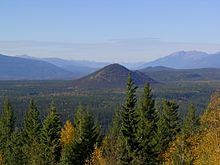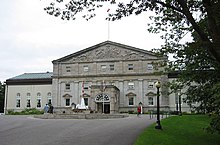Portal:Canada
| Showcase | Content | Contributing |
Introduction
Canada is a country in North America. Its ten provinces and three territories extend from the Atlantic Ocean to the Pacific Ocean and northward into the Arctic Ocean, making it the world's second-largest country by total area, with the world's longest coastline. Its border with the United States is the world's longest international land border. The country is characterized by a wide range of both meteorologic and geological regions. It is a sparsely inhabited country of 40 million people, the vast majority residing south of the 55th parallel in urban areas. Canada's capital is Ottawa and its three largest metropolitan areas are Toronto, Montreal, and Vancouver.
Canada is a parliamentary democracy and a constitutional monarchy in the Westminster tradition. The country's head of government is the prime minister, who holds office by virtue of their ability to command the confidence of the elected House of Commons and is appointed by the governor general, representing the monarch of Canada, the ceremonial head of state. The country is a Commonwealth realm and is officially bilingual (English and French) in the federal jurisdiction. It is very highly ranked in international measurements of government transparency, quality of life, economic competitiveness, innovation, education and gender equality. It is one of the world's most ethnically diverse and multicultural nations, the product of large-scale immigration. Canada's long and complex relationship with the United States has had a significant impact on its history, economy, and culture.
A developed country, Canada has a high nominal per capita income globally and its advanced economy ranks among the largest in the world, relying chiefly upon its abundant natural resources and well-developed international trade networks. Recognized as a middle power, Canada's strong support for multilateralism and internationalism has been closely related to its foreign relations policies of peacekeeping and aid for developing countries. Canada is part of multiple international organizations and forums. (Full article...)
Featured article -
The Wells Gray-Clearwater volcanic field, also called the Clearwater Cone Group, is a potentially active monogenetic volcanic field in east-central British Columbia, Canada, located approximately 130 km (81 mi) north of Kamloops. It is situated in the Cariboo Mountains of the Columbia Mountains and on the Quesnel and Shuswap Highlands. As a monogenetic volcanic field, it is a place with numerous small basaltic volcanoes and extensive lava flows. (Full article...)
Featured biography -
Marv Allemang (born 3 December 1953) is a former professional Canadian football offensive lineman and defensive lineman who played 14 seasons in the Canadian Football League (CFL). He most notably played center for the Hamilton Tiger-Cats and Ottawa Rough Riders later in his career. (Full article...)
National symbol -
The Canada jay (Perisoreus canadensis), also known as the gray jay, grey jay, camp robber, or whisky jack, is a passerine bird of the family Corvidae. It is found in boreal forests of North America north to the tree line, and in the Rocky Mountains subalpine zone south to New Mexico and Arizona. A fairly large songbird, the Canada jay has pale grey underparts, darker grey upperparts, and a grey-white head with a darker grey nape. It is one of three members of the genus Perisoreus, a genus more closely related to the magpie genus Cyanopica than to other birds known as jays. The Canada jay itself has nine recognized subspecies. (Full article...)
Selected vital article -
The Canadian Heraldic Authority (CHA; French: Autorité héraldique du Canada) is part of the Canadian honours system under the Canadian monarch, whose authority is exercised by the Governor General of Canada. The authority is responsible for the creation and granting of new coats of arms (armorial bearings), flags, and badges for Canadian citizens, government agencies, municipal, civic and other corporate bodies. The authority also registers existing armorial bearings granted by other recognized heraldic authorities, approves military badges, flags, and other insignia of the Canadian Forces, and provides information on heraldic practices. It is well known for its innovative designs, many incorporating First Nations symbolism. (Full article...)
Selected picture -
Current events
- June 19, 2024 – Canada–Iran relations
- Canada adds Iran's Islamic Revolutionary Guard Corps to its list of terrorist entities. (Bloomberg)
- June 12, 2024 –
- The Royal Canadian Geographical Society announces that a Canadian-led team has located the wreckage of Quest, the polar exploration ship of the Shackleton–Rowett Expedition off the coast of Labrador, Newfoundland and Labrador, Canada. (Reuters)
- May 31, 2024 –
- Canadian serial killer Robert Pickton dies in prison after being attacked by another inmate earlier this month. (AP)
- May 21, 2024 –
- Canadian serial killer Robert Pickton is reported to be on life support after being physically attacked in a prison in Port-Cartier, Quebec. (Vancouver Sun)
- May 18, 2024 –
- Three people are killed and five others are injured in a boat collision on Bobs Lake in Ontario, Canada. (CBC News)
- May 17, 2024 –
- A child in Hamilton, Ontario, Canada, dies of measles, the province's first such death since 1989. (CBC News)
Did you know -

- ... that Gil Kim played professional baseball in the Netherlands, China, Australia, Spain, and Venezuela, scouted in Mexico and the Dominican Republic, and coaches in Canada?
- ... that the Canadian journalist Bernard Descôteaux is credited with the economic revival of the independent newspaper Le Devoir?
- ... that Canadian politician Above Znoneofthe chose his name so as to be placed last on alphabetical ballots?
- ... that Annalee Newitz chose to set their debut novel Autonomous in the Canadian prairies because it was "the kind of place that often gets forgotten"?
- ... that Premier Maurice Duplessis, angry at the fact that the federal government of Canada was taking taxes at the expense of the provinces, once demanded that Ottawa "return our loot"?
- ... that a journalists' poll rated Billy Fitzgerald the second-best Canadian lacrosse player of the first half of the 20th century?
- ... that Banner in the Sky inspired a Canadian dentist to climb the Matterhorn?
Featured list -
Canada's national parks are protected areas under the Canada National Parks Act, owned by the Government of Canada and administered for the benefit, education, and enjoyment of the people of Canada and its future generations. National parks are administered by Parks Canada, a Crown agency operating under the jurisdiction of the Ministry of Environment and Climate Change. The goal of the national parks system is to set aside lands representing the country's 39 distinct natural regions described in the National Parks System Plan, primarily to protect the ecological integrity of the land, and secondarily to allow the public to explore, learn about and enjoy Canada's natural spaces. (Full article...)
Main articles
Associated Wikimedia
The following Wikimedia Foundation sister projects provide more on this subject:
-
Commons
Free media repository -
Wikibooks
Free textbooks and manuals -
Wikidata
Free knowledge base -
Wikinews
Free-content news -
Wikiquote
Collection of quotations -
Wikisource
Free-content library -
Wikiversity
Free learning tools -
Wikivoyage
Free travel guide -
Wiktionary
Dictionary and thesaurus
































